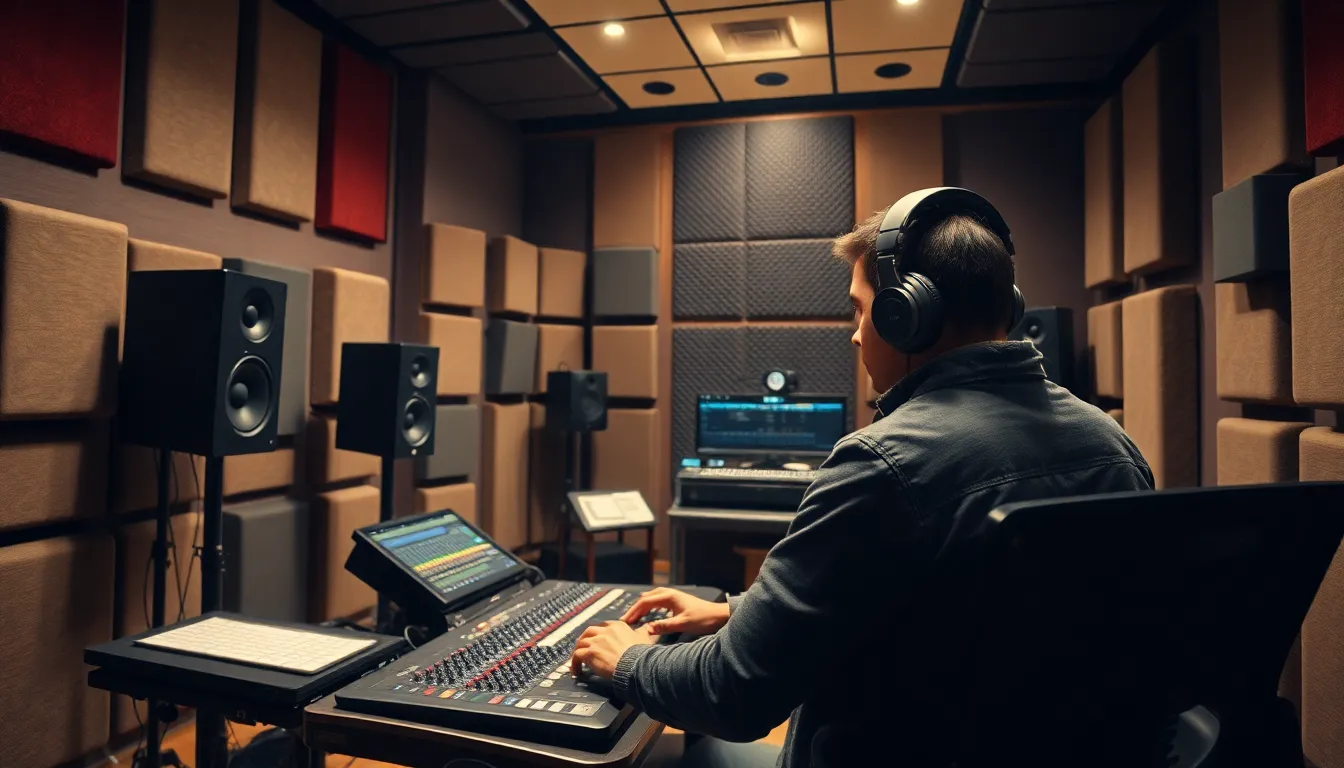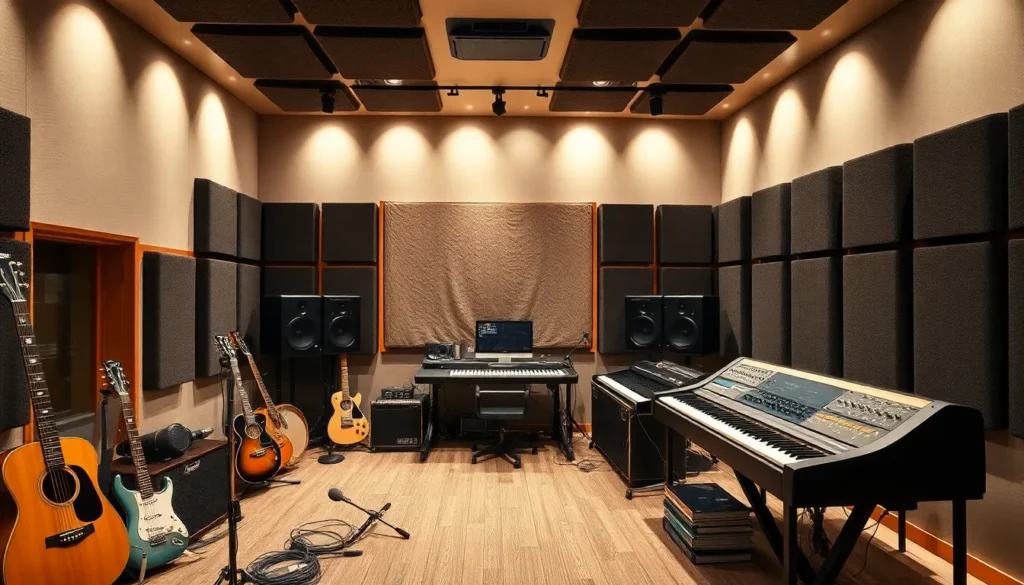In the world of sound, studio acoustics is the unsung hero. It’s the difference between a recording that sounds like a million bucks and one that makes you question your life choices. Imagine trying to capture the perfect melody while battling echoes that could rival a haunted house. That’s where acoustics come in, transforming chaotic noise into a symphony of clarity.
Whether you’re a seasoned pro or just starting out, understanding studio acoustics can elevate your sound game. It’s not just about slapping some foam on the walls and calling it a day. With the right techniques, you can create a space that not only sounds great but also inspires creativity. So, let’s dive into the art and science of studio acoustics, and discover how to turn your sound sanctuary into a masterpiece.
Table of Contents
ToggleUnderstanding Studio Acoustics
Studio acoustics play a crucial role in achieving optimal sound quality during recordings. Understanding how different elements influence sound can help create a better auditory experience.
Importance of Acoustic Treatment
Acoustic treatment minimizes unwanted sound reflections that distort recordings. Effective treatment enhances clarity and maintains a balanced frequency response. Bass traps absorb low frequencies, while diffusers scatter sound waves to avoid dead spots. Properly treating a studio leads to more accurate monitoring and mixing, which benefits both novice and experienced sound creators. Investing in acoustic treatment ensures the fidelity of recordings and allows artists to express creativity without interference from uncontrolled acoustics.
Common Acoustic Problems
Common acoustic problems include excessive reverberation and frequency build-up. Reflections from hard surfaces can create muddy sound, hindering the clarity of vocals and instruments. Fluctuating bass response results from an uneven distribution of soundwaves, affecting mix quality. Flutter echoes can cause distracting effects, particularly in smaller spaces. Understanding these issues enables sound creators to identify necessary solutions, ensuring a more professional and polished sound in their recordings.
Key Elements of Studio Acoustics

Studio acoustics consist of specific elements that impact sound quality and clarity. Understanding these key features allows sound creators to optimize their recording environments.
Soundproofing vs. Acoustic Treatment
Soundproofing focuses on preventing external noise from entering a studio, while acoustic treatment targets the sound within the space. Effective soundproofing uses materials like mass-loaded vinyl or double-layer drywall. This method minimizes outside interference. Acoustic treatment enhances sound quality by controlling reflections and resonances. Panels, bass traps, and diffusers achieve desirable audio conditions. Recognizing the distinct roles of soundproofing and acoustic treatment helps creators build a well-balanced recording environment.
Absorption, Diffusion, and Reflection
Absorption, diffusion, and reflection are vital in managing studio acoustics. Absorption materials, such as foam panels or fiberglass, soak up sound waves, reducing unwanted echoes. Diffusion scatters sound waves evenly throughout the space, promoting an open and natural sound. Reflective surfaces, such as hard walls, can enhance brightness but may lead to muddiness if not controlled. Striking a balance among absorption, diffusion, and reflection enhances the overall sonic experience, ensuring clarity and precision in recordings.
Tools and Techniques for Improving Studio Acoustics
Improving studio acoustics involves specific tools and techniques that enhance sound quality. Measurement tools for acoustics provide vital data to optimize any recording space.
Measurement Tools for Acoustics
Sound level meters measure volumes in decibels, helping identify loudness variations. RoomEQ Wizard analyzes frequency response, aiding in pinpointing anomalies in sound. RT60 meters assess reverberation time, offering insights into how long sound lingers in a space. These measurements guide adjustments in acoustic treatment. Utilizing smartphone apps also facilitates easier and more accessible acoustic analysis. Users benefit from real-time feedback, allowing for informed decisions on treatment materials and placements. Accurate measurements ensure that treatments effectively minimize unwanted reflections and enhance overall sound clarity.
DIY Acoustic Treatment Solutions
DIY solutions offer cost-effective ways to improve studio acoustics. Heavy curtains can absorb mid to high frequencies, reducing echo. Bookshelves filled with books act as natural diffusers, breaking up sound waves. Placing rugs on floors traps low frequencies and diminishes harsh reflections. Creating bass traps using simple foam or fiberglass can significantly reduce low-end buildup. Installation of angled panels encourages sound scattering and improves diffusion. These techniques empower users to make effective changes without professional assistance. Each solution contributes meaningfully to a studio’s acoustic environment.
Professional Studio Acoustics
Professional studio acoustics foster an environment conducive to high-quality recordings. Achieving the best sound requires detailed attention to treatment and design.
Hiring an Acoustic Consultant
Engaging an acoustic consultant brings specialized knowledge into studio design. Consultants assess unique space requirements, ensuring solutions are tailored to specific acoustic challenges. They evaluate sound issues like frequency build-up and undesired reflections. Additionally, acoustic experts recommend effective treatments through acoustic panels, bass traps, or diffusers. Expert guidance helps streamline the design process, preventing costly mistakes. Ultimately, their insights help creators achieve balanced and precise sound.
Case Studies of Successful Studio Designs
Examining successful studio designs illustrates the impact of proficient acoustics. Many renowned studios prioritize acoustic treatment to enhance sound quality. For instance, Studio A at Ocean Way Nashville employs a combination of absorption and diffusion strategies. The design reduces flutter echoes while maintaining clarity. Another example includes Abbey Road Studios, which successfully integrates both historical charm and modern treatment techniques. These case studies reveal how thought-out acoustics contribute to professional-grade recordings, demonstrating the significance of effective sound management.
Investing time and resources into studio acoustics can significantly elevate sound quality and creativity. By understanding the nuances of acoustic treatment and soundproofing, sound creators can craft spaces that enhance their recordings. Utilizing measurement tools and DIY solutions empowers individuals to take control of their environments without breaking the bank.
For those seeking professional results, consulting with an acoustic expert can provide tailored strategies to tackle unique challenges. Ultimately, mastering studio acoustics is key to achieving polished recordings that resonate with clarity and precision.

